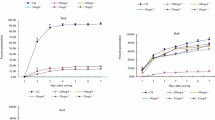Abstract
The n-hexane-, acetone- and water-soluble fractions obtained from an aqueous acetone extract of lemon balm (Melissa officinalis L.) shoots inhibited the germination and the growth of roots and shoots of cockscomb (Amaranthus caudatus L.), cress (Lepidium sativum L.), crabgrass (Digitaria sanguinalis L.), timothy (Phleum pratense L.), lettuce (Lactuca sativa L.) and ryegrass (Lolium multiflorum Lam.). The inhibitory activity of the water-soluble fraction was the greatest, followed by that of acetone- and n-hexane-soluble fractions in all bioassays. The effectiveness of these fractions on the roots was greater than that of the shoots of the test plants. Significant reductions in the germination and growth of the roots and shoots were observed as the extract concentration increased. Such rate-dependent responses of the test plants to the fractions suggest that each fraction might contain allelochemical(s), but that the greatest potential was in the water-soluble fraction.
Similar content being viewed by others
Abbreviations
- I25 :
-
doses required for 25% inhibition
References
Babu R.C., Kandasamy O.S. 1997. Allelopathic effect of Eucalyptus globulus Labill. on Cyperus rotundus L. and Cynodon dactylon L. Pers. J. Agron. Crop Sci. 179: 123–126.
Bell A.B. 1981. Biochemical mechanisms of disease resistance. Annu. Rev. Plant Physiol. 32: 21–81.
Bhowmik P.C., Doll J.D. 1982. Corn and soybean response to allelopathic effects of weed and crop residues. Agron. J. 74: 601–606.
Caussanel J.P. 1979. Non-competitive effects between lamb’s quarters (Chenopodium album L.) and maize (INRA 258). Weed Res. 19: 123–135.
Chung I.M., Miller D.A. 1995. Natural herbicide potential and alfalfa residue on selected weed species. Agron. J. 87: 920–925.
Duke S.O. 1986. Naturally occurring chemical compounds as herbicides. Rev. Weed Sci. 2: 17–65.
Einhellig F.A. 1996. Interactions involving allelopathy in cropping systems. Agron. J. 88: 886–893.
Gross D., Parthier B. 1994. Novel natural substances acting in plant growth regulation. J. Plant Growth. Regul. 13: 93–114.
Hu F.D., Jones R.J. 1997. Effects of plant extracts of Bothriochloa pertusa and Urochloa mosambicensis on seed germination and seedling growth of Stylosanthes hamata cv. Verano and Stylosanthes scabra cv. Seca. Aust. J. Agric. Res. 48: 1257–1264.
Inderjit. 1996. Plant phenolics in allelopathy. Bot. Rev. 62: 186–202.
Inderjit., Dakshini K.M.M. 1992. Formation 7-O-glucoside (ononin), an additional growth inhibitor in soils associated with the weed, Pluchea lanceolata (DC) C.B. Clarke (Asteraceae). J. Chem. Ecol. 18: 713–718.
Mahall B.E., Callaway R.M. 1991. Root communication among desert shrubs. Proc. Natl. Acad. Sci. USA 88: 874–876.
May F.E., Ash J.E. 1990. An assessment of the allelopathic potential of Eucalyptus. Aust. J. Bot. 38: 245–254.
Putnam A.R. 1988. Allelochemicals from plants as herbicides. Weed Technol. 2: 510–518.
Putnam A.R., Tang C. 1986. The Science of Allelopathy. John Wiley and Sons, New York.
Rice E.L. 1984. Allelopathy, 2nd ed. Academic Press, Orlando, Florida.
Seigler D.S. 1996. Chemistry and mechanisms of allelopathic interactions. Agron. J. 88: 876–885.
Tagashira M., Ohtake Y. 1998. A new antioxidative 1,3-benzodioxole from Melissa officinalis. Planta Med. 64: 555–558.
Van den Berg T., Freundl E., Czygan F.C. 1997. Melissa officinalis subsp. altissima: Characteristics of a possible adulteration of lemon balm. Pharmazie 52: 802–808.
Yu J.Q., Matsui Y. 1997. Effects of root exudates of cucumber (Cucumis sativus) and allelochemicals on ion uptake by cucumber seedlings. J. Chem. Ecol. 12: 817–827.
Author information
Authors and Affiliations
Rights and permissions
About this article
Cite this article
Kato-Noguchi, H. Effects of lemon balm (Melissa officinalis L.) extract on germination and seedling growth of six plants. Acta Physiol Plant 23, 49–53 (2001). https://doi.org/10.1007/s11738-001-0022-0
Received:
Accepted:
Issue Date:
DOI: https://doi.org/10.1007/s11738-001-0022-0




